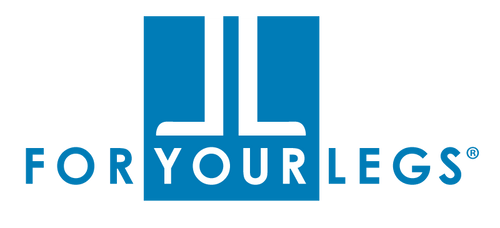Learn More About Vein Health
Do you have tired, achy legs? Do your legs and ankles swell? Do you see what may appear to be the onset of varicose veins? About 50% of women and 40% of men in the United States suffer from some kind of vein problem. Now is the time to learn how to improve your vein health! Vein problems shouldn't be ignored and can progressively worsen over time. If neglected, vein problems can affect your health for the rest of your life.
Read below to learn more about vein disorders and how wearing compression legwear can help.
Blood Flow
The heart is a muscle that pumps oxygen-rich blood through the arteries and into tiny capillaries where cells exchange oxygen for carbon dioxide. The blood then enters the veins, which carry blood back to the heart. However, on its way up the legs, the blood must fight gravity, which makes it more difficult for it to return back to the heart. Wearing compression legwear can help the blood fight this gravity and improve your overall blood circulation by applying graduated pressure to certain areas of your legs.
There are two types of veins in the legs: the surface or superficial veins and the deep veins. Venous blood in the surface veins emptied into the deep veins, which take the blood back to the heart.
There are two ways to help blood move up the legs. The first is with help from the calf muscles. These muscles surround the deep veins and contract and relax as a person walks, which squeezes the deep veins to help push the venous blood up the veins. The second is by one-way valves in both the surface and deep veins. When calf muscles contract, these valves open to allow blood to flow back to the heart, and when calf muscles relax they close to prevent blood from flowing backward into the lower part of the vein. These valves are fragile and are easily damaged.
Common Vein Disorders
- Varicose veins is one of the most common venous disorders. Varicose veins are twisted, enlarged veins located near or raised above the surface of the skin. Varicose veins are often dark blue in color and are most commonly seen on the legs (but they can occur anywhere on the body). These veins connect with the deep veins of the leg and play a minor role in the transfer of blood to the heart. In the majority of cases, varicose veins are just a cosmetic nuisance.
They are caused by the pooling of blood in a damaged vein and can be painful (and sometimes they may not cause any discomfort at all). In the early stages of varicose veins, the legs may feel tired, tense, restless, tingly, heavy, crampy, or achy. They can also cause discoloration, rashes, or skin ulcerations on the ankles or lower legs.
20-30 mmHg is the most commonly selected level of compression for varicose veins. The compression level that is best for you will depend on the severity of your symptoms. Please consult with your physician or healthcare professional to determine the compression best suited for you.
- Phlebitis is the inflammation of a vein wall and is the most common problem associated with varicose veins. Symptoms can include pain, discomfort, swelling, redness, and heat in the irritated area.
- Superficial Thrombophlebitis is a blood clot in a superficial (surface) vein that can be caused by irritation or are similar to, but more severe than, those associated with phlebitis.
Blood Clots
- A Deep Vein Thrombosis (DVT) is a blood clot in one of the deep veins, which can save a life when they stop unnecessary bleeding, but can also have life-threatening consequences and cause heart attacks, strokes, and other serious medical problems. Symptoms of a DVT include swelling and pain in the affected area of your leg.
About 25% of DVTs move away from the deep veins where they form and flow through the bloodstream to the lungs. This is known as a pulmonary embolism (PE), and can also be life-threatening. Symptoms can include shortness of breath, chest pain, feeling light-headed, coughing up blood, and a rapid pulse. If you experience any of these symptoms, seek medical attention immediately.
- Chronic Venous Insufficiency (CVI) is a condition in which the veins are constantly congested with pooled blood, causing circulation to be significantly impaired. Symptoms include edema (swelling), heaviness in the legs, pain or cramps in the calves, uncomfortable puffiness of the feet and ankles (that typically subsides during the night), skin discolorations, dermatitis (skin problems), and dry or weeping eczema.
- A Venous Leg Ulcer is an open wound that usually forms near the ankle and is due to chronic poor circulation. The ulcer has a weeping, raw appearance and the skin surrounding the ulcer is dry, itchy, and brownish or blackish in color. Venous leg ulcers are usually slow to heal.
Compression Therapy
The key to treating vein diseases lies in improving blood flow to the affected area. Compression therapy is the most common approach for managing venous disorders. Compression garments apply pressure to the area in order to help the blood flow.
Knowing and understanding how vein diseases impact the body is essential to understanding how compression therapy can manage each disorder. Shop our compression garments and find a pair that works for you.
Please talk with your doctor or healthcare provider before wearing compression 20 mmHg and greater.


I have been wearing support stockings for about 10 years. This year I have been noticing that especially after taking off my stocking that my legs are numb feeling, not completely numb, and it feels like i have a band around my instep. I have orastatic hypotension and wear 15mg 20mg hose. Is this caused by wrong size hose. My ankle is 8 and calf 13"
Reading your site. I wear #13703 medi closed toe 20-30 size L; – Diabetes; 5’4" weight 235 lb. Carpel tunnel surgery left hand 2/2013 now returned.
Carpel tunnel surgery left hand 2/12/2013
;now left foot. Only left hand surgery Have worn compression knee high hose long time; sometime with open sores. age 73 with diabetes.
I had swelling of feet and ankles and I thought it was the side-effect of Gabapentin ,but the swelling has now gone down. I am a senior and need an appropriate knee-high sock that I am able to handle. Thanks
Hi, my mom legs get really bad traveling . What will you recommend for her. she is 80 and im 45 i need something for me also. Thanks in advance.
Leave a comment